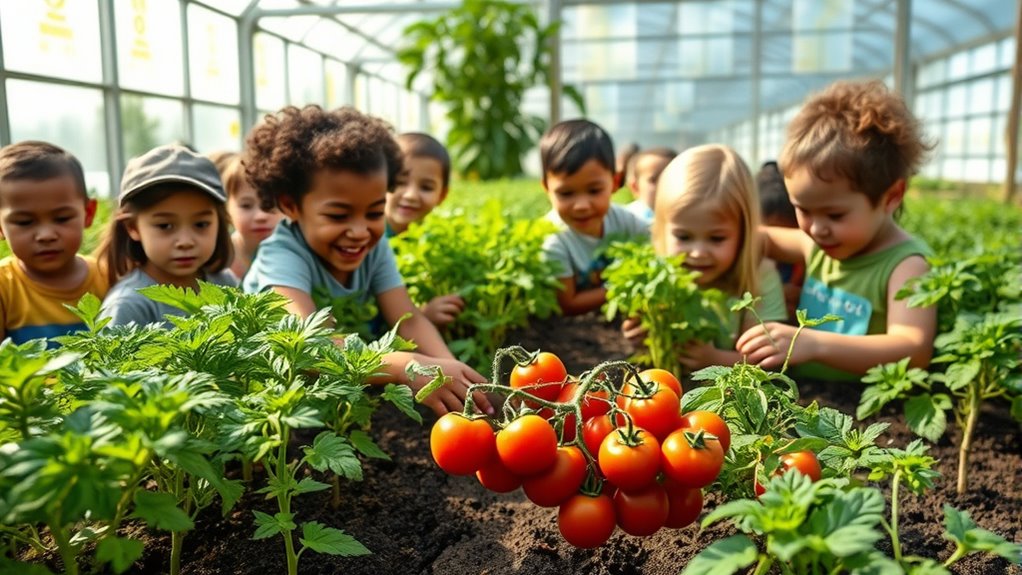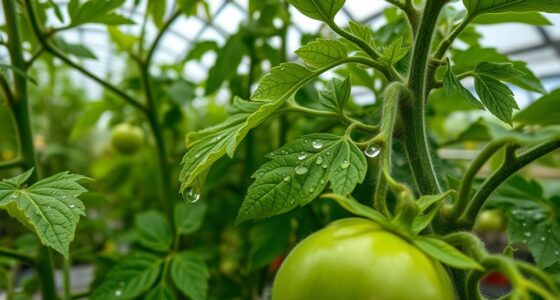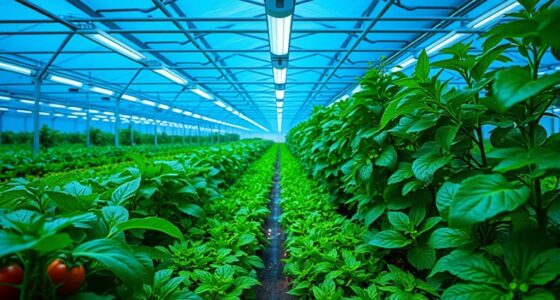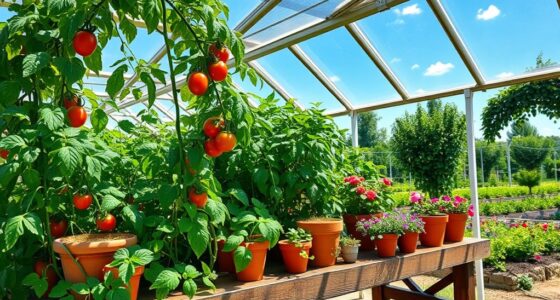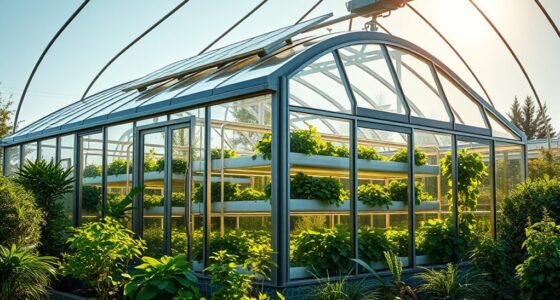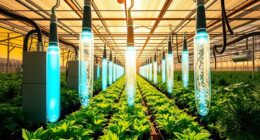Greenhouses in education are game-changers for teaching sustainability. You engage in hands-on learning, experimenting with plant growth and eco-friendly practices. These living labs enrich your understanding of environmental issues through gardening and innovative agricultural techniques like hydroponics. You also explore data analysis in STEM projects and develop critical thinking skills while reducing food waste in your community. Curious about how greenhouses can further enhance your learning and connections? Let’s explore more possibilities together.
Key Takeaways
- Greenhouses provide hands-on learning experiences that connect students with sustainable practices and environmental issues.
- They serve as living laboratories, promoting STEM education through experiments in plant growth and resource management.
- Gardening activities foster ecological literacy, teaching students about local food production and environmental responsibility.
- Collaborative greenhouse projects encourage community connections and shared responsibility for sustainable practices.
- Greenhouses enhance critical thinking and problem-solving skills, preparing students for future careers in agriculture and environmental science.
The Role of Greenhouses in Hands-On Learning

While many classrooms focus on theoretical lessons, greenhouses transform education by providing immersive, hands-on learning experiences.
You’ll find greenhouses serve as living laboratories for STEM education, allowing you to experiment with plant growth and environmental conditions. Here, you can design and test automated irrigation systems, merging technology with plant care. Additionally, constructing your own greenhouse can enhance your DIY skills, making the experience even more rewarding. Incorporating data analysis in your greenhouse projects can further enhance your understanding of plant growth patterns. Furthermore, utilizing solar energy in your greenhouse can promote sustainable practices and reduce reliance on traditional power sources.
The controlled environment enables year-round plant growth, letting you explore variables like light and soil composition in real-time. This practical approach deepens your understanding of biology, ecology, and photosynthesis. Additionally, greenhouses provide dynamic, living labs for energy management and sustainability, inspiring innovative solutions to agricultural challenges.
The greenhouse’s controlled environment fosters year-round growth, enhancing your grasp of biology, ecology, and the intricacies of photosynthesis.
As you nurture and observe plants, you’ll develop skills in data collection and analysis, making classroom theories tangible. Greenhouses truly foster critical thinking, preparing you to tackle real-world agricultural challenges with confidence.
Promoting Environmental Awareness Through Gardening

Gardening in schools not only connects students with nature but also deepens their understanding of environmental issues. Through hands-on experiences, you learn about edible plants and the importance of sustainability practices. As you dig into the soil, you foster a sense of responsibility and develop positive attitudes toward science and the environment. School gardens promote nature-friendly attitudes, enhancing your ecological literacy and encouraging inquiry-based learning. Engaging in gardening helps you understand real-life contexts of environmental education, such as the role of pollinators and the benefits of organic methods. Additionally, participating in school gardening projects teaches sustainability concepts, cultivating an awareness of how our actions impact the environment. Long-term involvement in gardening cultivates a lasting appreciation for nature, empowering you to make environmentally conscious decisions and advocate for sustainable practices in your community.
Integrating Greenhouses Into Diverse Curricula

Integrating greenhouses into diverse curricula not only enriches the educational experience but also creates a dynamic platform for hands-on learning across multiple subjects.
In science classes, you’ll explore plant life cycles and ecosystems, while math lessons can involve measuring growth and analyzing data trends. The greenhouse provides a concrete context for sustainability practices, fostering awareness of conservation. Understanding financial considerations for maintaining greenhouse operations can also be a relevant topic for students. Additionally, students can learn about camping essentials that include outdoor cooking and food storage techniques, which are vital for sustainable living. This knowledge can enhance their ability to prepare for natural disasters and engage in effective emergency response.
Environmental science courses benefit from teaching sustainable practices, fostering awareness of conservation.
You can even leverage technology by using sensors and apps to monitor greenhouse conditions.
Collaborative interdisciplinary projects encourage deeper understanding, blending STEM with social sciences.
This integration not only enhances engagement but also prepares you for real-world challenges, making learning relevant and exciting.
Embracing these opportunities can transform your educational journey and inspire future generations.
Addressing Food Sustainability and Community Impact
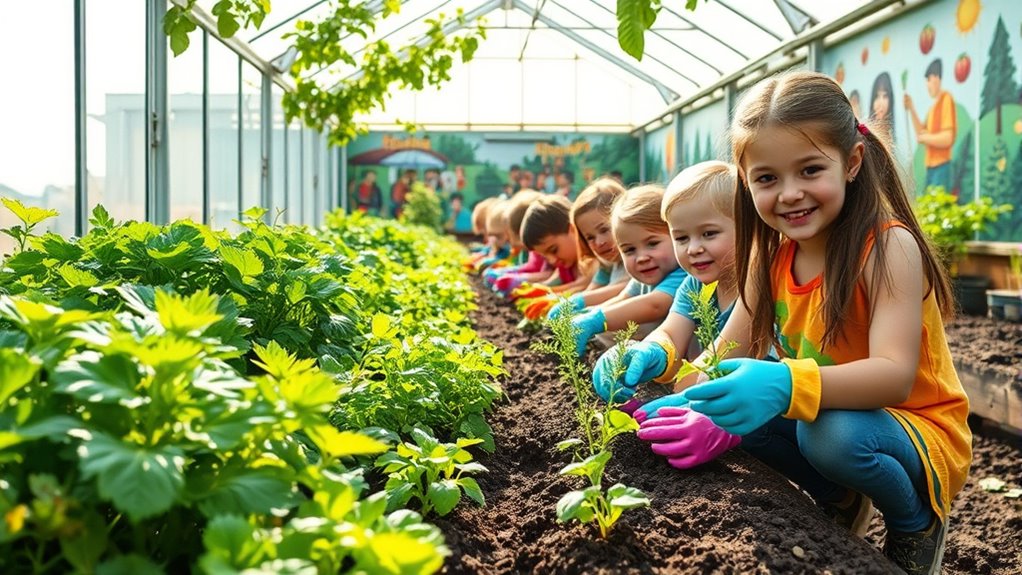
As you explore the role of greenhouses in education, you’ll discover their significant impact on food sustainability and community well-being.
Greenhouses serve as essential tools for teaching students about reducing food waste, which contributes to 8-10% of global greenhouse gas emissions. By incorporating organic learning gardens in schools, you’ll help students understand efficient resource use and the importance of fresh produce. Additionally, education on dietary changes can lead to quantifiable reductions in greenhouse gas emissions, helping students recognize the broader impact of their food choices. Teaching students about water sources in their locality can further enhance their understanding of sustainable farming practices. Understanding the benefits of community gardens can also encourage students to engage more deeply with local food systems. Furthermore, introducing students to best dog training guides can highlight the importance of responsible pet ownership and its connection to community health.
Engaging with greenhouses fosters community connections, improves access to healthy food, and enhances dietary habits. Events centered around these spaces can raise awareness about sustainable practices, making a collective impact on food security.
Ultimately, greenhouses in education not only promote environmental responsibility but also empower students to become advocates for a sustainable future.
Fostering Innovation and Problem-Solving Skills
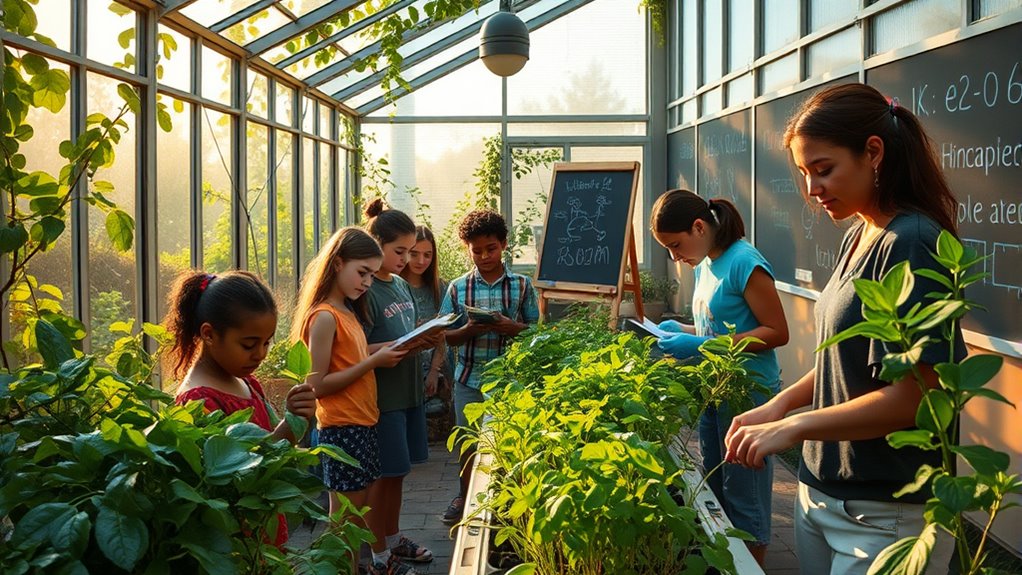
Greenhouses not only enhance food sustainability and community engagement but also serve as dynamic environments for fostering innovation and problem-solving skills in students.
In these living laboratories, you can conduct hands-on experiments, exploring plant growth and environmental conditions. By designing automated irrigation systems, you’ll integrate technology with environmental science, enhancing your understanding of biological processes. The integration with digital platforms allows you to monitor environmental conditions, further enriching your learning experience. Additionally, understanding color accuracy can help you optimize lighting conditions for plant growth. Incorporating STEM toys in your greenhouse projects can further enhance critical thinking and problem-solving skills. Furthermore, engaging in activities like using balance bikes can develop coordination and foster collaboration among students in the greenhouse setting.
The controlled environment allows you to manipulate variables like light and humidity, optimizing plant growth. You’ll tackle real-world challenges, such as pest management and sustainable practices, honing your critical thinking.
Engaging in innovative agricultural techniques like hydroponics inspires creativity and encourages you to develop unique solutions, preparing you for future careers in agriculture and environmental science.
Building Connections Between Schools and Communities
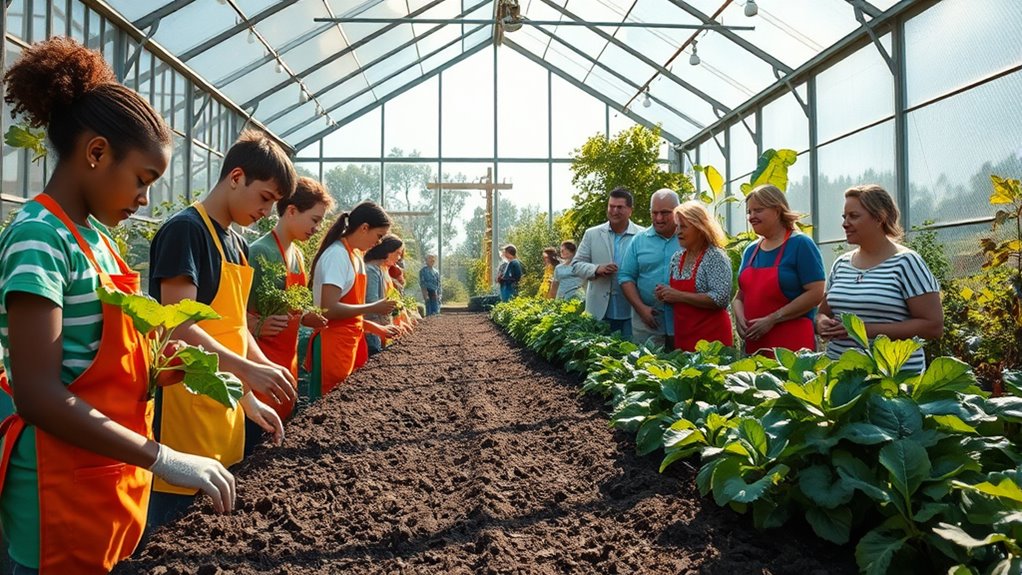
When schools partner with their communities, they create powerful connections that enhance both educational experiences and local engagement. These partnerships, involving organizations like colleges and community groups, lead to improved academic outcomes and stronger social skills for students. By collaborating on projects like greenhouses, you promote sustainability while involving community members, fostering shared responsibility. Additionally, school-community partnerships can provide essential resources and support systems that strengthen the learning environment. Resource sharing becomes easier, allowing schools to access expertise and data that support learning and development. For example, integrating historical farm museums can enrich students’ understanding of local agricultural practices. Moreover, local food production encourages hands-on learning experiences that align with sustainable practices and awareness. Engaging in outdoor play and active toys can also help children develop a sense of responsibility towards the environment. Regular communication is key, ensuring everyone stays aligned and engaged. Ultimately, these partnerships benefit both schools and communities, promoting local food production, economic growth, and environmental awareness. By working together, you can create a more equitable and supportive educational environment for all.
Frequently Asked Questions
What Types of Plants Are Best Suited for Educational Greenhouses?
When you choose plants for educational greenhouses, consider varieties that engage students. Easy-to-grow options like nasturtiums and marigolds add color while attracting pollinators.
Incorporate herbs like basil for lessons on nutrition. Sunflowers and sweet peas facilitate hands-on learning about growth and germination.
Include succulents to teach water conservation. By selecting a mix of edible and sensory plants, you create a dynamic environment that fosters curiosity and hands-on experiences.
How Can Teachers Assess Student Learning in Greenhouse Projects?
Imagine a classroom buzzing with excitement as students showcase their vibrant greenhouse designs.
To assess student learning in these projects, you can employ group discussions, exit tickets, and multimedia presentations. Encourage them to reflect on their experiences and choices using structured handouts.
What Maintenance Is Required for School Greenhouses?
To maintain school greenhouses, you’ll need to focus on several key areas.
Clean the exterior biannually and regularly disinfect interiors to keep pests at bay.
Check the structural integrity by inspecting frames, covering materials, and foundations.
Manage environmental conditions by monitoring temperature, humidity, and lighting.
Finally, involve students in maintenance tasks and create rotation schedules to guarantee everyone stays engaged in the upkeep of the greenhouse.
Are There Grants Available for Funding Greenhouse Projects in Schools?
Oh sure, because who wouldn’t want to fund a greenhouse?
Thankfully, grants are out there, just waiting for you to stumble upon them! USDA grants, Perkins grants, and even crowdfunding can help you turn that dream into reality.
Look into local businesses and nonprofits; they might be itching to support your green ambitions.
Just remember, grant writing’s a sport, so brush up on your skills and get ready to play!
How Can Schools Ensure Student Safety in Greenhouse Environments?
To guarantee student safety in greenhouse environments, you should provide thorough training on safety equipment and emergency procedures.
Make certain all safety gear is easily accessible and that everyone knows how to use it. Conduct regular inspections of equipment, maintain proper ventilation, and keep surfaces slip-resistant.
Supervise all activities closely, enforce no-horseplay policies, and guarantee students wear appropriate clothing.
Conclusion
Incorporating greenhouses in education isn’t just a trend; it’s a game-changer for teaching sustainability. By engaging students in hands-on learning, you’re planting the seeds for a greener future. As they cultivate their gardens, they’ll also grow their awareness of environmental issues and community needs. With these experiences, you’re not only nurturing their minds but also fostering the innovation they’ll need to tackle tomorrow’s challenges. Let’s get growing together and watch our future flourish!
